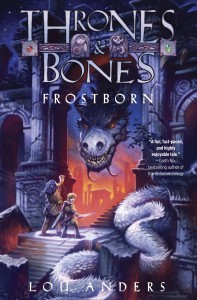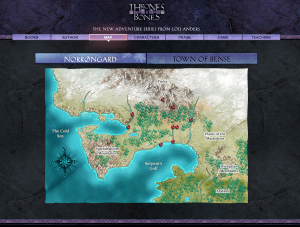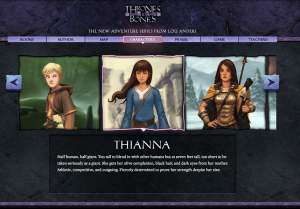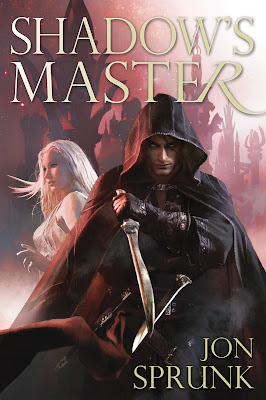 Today we’re going to talk fantasy lit with a very special guest. Lou Anders is the Hugo Award-winning editorial director of Pyr Books. He’s won the Chesley Award for his art direction. And he’s also a great friend of mine. A man of mighty intellect, powerful stage presence, and an unquenchable love for all things scifi/fantasy.
Today we’re going to talk fantasy lit with a very special guest. Lou Anders is the Hugo Award-winning editorial director of Pyr Books. He’s won the Chesley Award for his art direction. And he’s also a great friend of mine. A man of mighty intellect, powerful stage presence, and an unquenchable love for all things scifi/fantasy.
Jon: Lou, I needed to talk to you today because something very exciting has happened. Your first novel has been published. Congratulations! For those of you who don’t know, Lou’s debut novel is a fantasy called Frostborn. Lou, tell us more. What’s it about?
Lou: Frostborn is a middle grade fantasy novel for boys and girls ages 8-12. It’s the first novel in the Thrones and Bones series, and is about a boy growing up on a large farm in the country of Norrøngard who meets a girl who is half-giant, half-human. The two of them are both ousted from their normal lives by unforeseen circumstances, meet in the snowy wilderness, and have to combine forces to survive and to turn the tables on their respective enemies. The culture of the Norrønir factors heavily in the book, something I’m quite proud of, and along the way we encounter trolls, draug, snow sprites, foreign warriors, and a very dangerous dragon. There’s an incredible website with character art, two interactive maps, and a playable game (which works on mobile too) at www.thronesandbones.com, and the book itself contains the rules for playing the board game Thrones and Bones, which is a Norrønir pastime that features in the plot of the novel.
Jon: That sounds like a book my son and I will enjoy reading together. How did you come up with the setting of Norrøngard?
Lou: Norrøngard and its people, the Norrønir, took a lot of work. The character of Thianna the half-giant preceded the book by a couple years. She appeared in a terrible sword and sorcery short story I wrote in 2010. I junked the story but liked the character and decided to explore her childhood. Around the same time my own writing attempts were leading me more and more into middle grade fiction as my chosen arena. So having settled on telling her “origin story” I started thinking about where she was from. I set aside any consideration of plot or theme and spent about three months just building the land. And because I didn’t want to get stuck in anything I didn’t intend later, I didn’t just construct a country but an entire world. Norrøngard is just one country in a continent of around 30 countries and territories, one a planet of four massive continents, one smaller island-continent, and quite a few islands. Right now I can tell you what’s going on in most of those 30, and give you detailed histories going back thousands of years in quite a few of those. I’ve also got a fairly good idea of what’s happening on the other continents (though I’m trying to save some of that for later so I don’t fill the world up too fast).
But back on Norrøngard. Right off the name gave me fits, if only because a lot of great sounding, fictional names that start with N are already out there. Númenor, Norns, Northmen… I tried out a few before I found the perfect one. Norrøn is the word for Norse and gard means a garden, dwelling, enclosed place or land. So Norrøngard is the land of the Norse. (Midgard, for those wondering, means “the middle land,” so now you know where “Middle Earth” came from.)
I realized I needed to know the history of the country, so I started working on a timeline stretching back to the Norrønir’s concept of the creation of the universe (which differs radically from our real world one), referencing Norse history as I did so. It was then it really hit home just how far the Vikings traveled and how influential their culture was. I discovered I couldn’t really understand them unless I charted out their interactions with their neighbors. And their neighbors’ neighbors. And their neighbors’ neighbors’ neighbors. So I was building histories of Araland, Saisland, Ungland, Swithenmark… Araland, their nearest neighbor, has a five thousand year history going back to its creation myth (different from the Norrønir version). You get where this is going.
After three months of this I sat down to write the book. Flash forward to the end of the first draft, starting with the city of Bense and then moving on to the country map. Somewhere in there, the book sells to Random House Children’s Books, and I find myself working on my editor-requested revisions the same two weeks I’m in Norway! So I’m touring the Norwegian landscape by day, sailing down fjords and ascending mountain peaks, and working on novel revisions by night. And each night, I’m sending my cartographer Robert Lazzaretti (of D&D and Pathfinder fame) photos I’ve taken during the day, and we’re adjusting the map appropriately. I cannot possibly express how amazing it was to photograph a landscape during the day and then input that geography into my own world that evening. Meanwhile, next year I get to show off the Continent of Katernia map, along with three other maps we’ve done since that haven’t been made public yet!
Jon: You have children of your own. Did they play any part in your thought process when writing Frostborn?
Lou: Very much so. To begin with, having worked in the adult field for over a decade, editing stories that won’t be appropriate for them for many years, I really wanted to write something they could read and enjoy now (or in my youngest’s case, soon-ish). I’m also reading a lot of middle grade books with my boy, so seeing what he likes and doesn’t like is very informative. But after I finished writing and my son was reading my first draft, he pointed out something that had never occurred to me. In crafting a tale of an introspective, game-obsessed boy and an outgoing, assertive, aggressive girl, I was writing about my own children without realizing it.
Jon: That’s hilariously and it often happens. What inspires your writing? Favorite authors? Musicians? Painters?
Lou: Music is always a big influence on me, whatever I’m working on. For this series, I’ve made a playlist that mixes Howard Shore’s score for The Fellowship of the Ring and his The Hobbit; An Unexpected Journey (extended versions of both of course), with Jeremy Soule’s Skyrim soundtrack, and, in preparation for book three, I’ve just added John Powell’s How to Train Your Dragon 2 and two versions of Carl Orff’s “O Fortuna,” (which you may remember from its use in the climax of the film Excalibur). Also, I blasted “O Fortuna” on the way to my first reading/signing to help get in the mood.
Favorite authors I shouldn’t answer, though Michael Moorcock’s influence on both me and on our entire field (and RPGs, video games, pop culture in general) cannot be understated. William Gibson was also a favorite for a while. As to my favorite musicians, I love David Bowie, Robyn Hitchcock, the Counting Crows, the Mountain Goats, Beck, and the Beatles. Those are probably the all time favorites, but let’s add a fondness for Dylan’s bootleg series and a deep and abiding respect for Annie Lennox. I shouldn’t answer favorite artists either, though as a kid I had art books by Roger Dean, Boris Vallejo, the Brothers Hildebrandt, and Patrick Nagel, and I adored the work of Neal Adams, Marshall Rogers, Drew Struzan and Robert McGinnis.
Film is a very big influence on my work (Casablanca all time favorite! Miller’s Crossing is a close second), as are travel and video games.
Jon: So many influential artists there. That really strikes home with me as author. But you’re also editor-in-chief and art director for Pyr Books. So what does a typical day in the life of Lou Anders look like?
Lou: Ha. It looks like about three or four different days sandwiched together. And a lot of late nights. People who don’t know any better think all editors do is read. If only! Most of the editors I know read on weekends and on the train in and out of NYC. Since I work from a home office in Alabama, I don’t get that train reading time! And as to writing, Frostborn was written from 9pm to 1am, every Monday to Thursday, and an 8 hour session every other Sunday, for about four months.
Jon: Well, Lou. I know you’re a busy man, so I’ll let you get back to writing the sequel. Thank you so much for stopping by today.
Lou: Thank you very much Jon. The busy man says that his highscore on the thronesandbones.com online game stands at 25. Think you can beat it?
Jon: There you have it, folks. Lou Anders, a man of many talents and passions. Please do yourself (and your kids) a favor and check out Frostborn.
————
Lou Anders’s research on Norse mythology while writing Frostborn turned into a love affair with Viking culture and a first visit to Norway. He hopes the series will appeal to boys and girls equally. Anders is the recipient of a Hugo Award for editing and a Chesley Award for art direction. He has published over 500 articles and stories on science fiction and fantasy television and literature. Frostborn, which Publishers Weekly described as “thoroughly enjoyable” (starred review), is his first middle grade novel. A prolific speaker, Anders regularly attends writing conventions around the country. He and his family reside in Birmingham, Alabama. You can visit Anders online at louanders.com and ThronesandBones.com, on Facebook, and on Twitter at @ThronesandBones.






